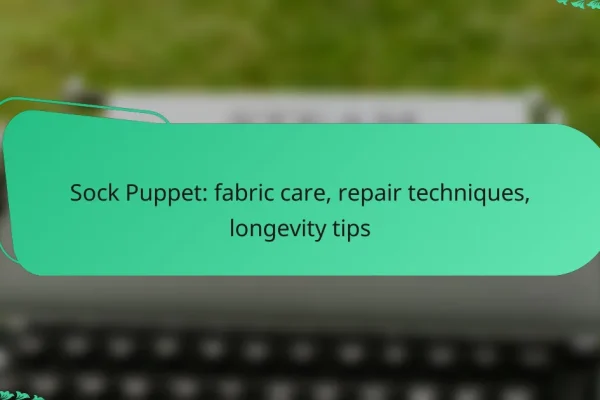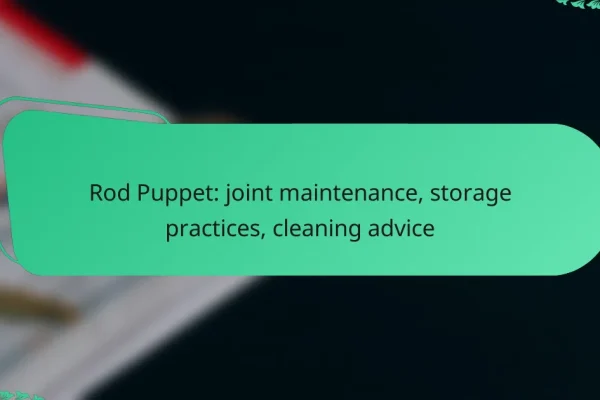How to Clean Your Puppets Effectively?
Cleaning your puppets effectively involves using the right materials and techniques to preserve their appearance and functionality. Regular maintenance can extend the life of your puppets and keep them looking vibrant.
Use mild soap and water
When cleaning your puppets, always opt for mild soap and lukewarm water. Harsh chemicals can damage the materials, so a gentle dish soap or a baby shampoo is ideal. Mix a small amount of soap with water, ensuring it is well-diluted before applying it to the puppet.
Use a soft cloth or sponge to gently wipe down the puppet’s surface. Focus on areas that accumulate dirt or grease, such as the hands and face, while avoiding excessive scrubbing that could wear down the fabric or paint.
Utilize a soft brush for details
A soft brush is essential for cleaning intricate details of your puppets, such as facial features or textured fabrics. A small, clean paintbrush or a makeup brush can effectively remove dust and debris without causing damage.
Gently brush the puppet’s details in a sweeping motion, ensuring you reach crevices where dirt may hide. This technique helps maintain the puppet’s overall appearance and prevents buildup that could affect its functionality.
Air dry in a shaded area
After cleaning, allow your puppets to air dry in a shaded area, away from direct sunlight. Sunlight can fade colors and weaken materials over time, so it’s crucial to choose a cool, dry spot for drying.
Ensure that the puppets are positioned in a way that allows air circulation around them. Avoid using heat sources like hair dryers, as these can cause warping or damage to the puppet’s structure and materials.
What are the Best Storage Practices for Puppets?
The best storage practices for puppets involve keeping them in environments that prevent damage and deterioration. Proper storage ensures that your puppets remain in good condition for performances and displays.
Store in a cool, dry place
Storing puppets in a cool, dry place is essential to prevent mold and mildew growth. Ideal temperatures range from 15°C to 25°C (59°F to 77°F), with humidity levels below 50% to maintain the integrity of materials.
Avoid areas with extreme temperature fluctuations, such as attics or basements. Instead, consider a dedicated storage box or cabinet that can help regulate the environment and keep your puppets safe.
Use protective covers for delicate materials
Using protective covers for puppets made of delicate materials, such as silk or paper, can significantly extend their lifespan. Soft, breathable fabric covers can shield them from dust and physical damage while allowing airflow.
When selecting covers, ensure they are acid-free to avoid chemical reactions that could harm the puppet. Regularly inspect the covers for wear and replace them as needed to maintain optimal protection.
How to Repair Damaged Puppets?
Repairing damaged puppets involves assessing the type of damage and applying appropriate fixes. Quick repairs can often be done at home, while more significant issues may require professional help.
Identify the type of damage
Start by examining the puppet closely to determine the nature of the damage. Common issues include torn fabric, broken joints, and detached parts. Understanding the specific type of damage will guide your repair approach.
For instance, small tears in the fabric can often be fixed easily, while structural damage may need more intensive work. Take note of any missing pieces, as these will need to be replaced or reattached.
Use fabric glue for small tears
For minor fabric tears, fabric glue is an effective solution. Apply a small amount of glue to the edges of the tear and press them together, ensuring they align properly. Hold the fabric in place until the glue sets, which usually takes a few minutes.
Be cautious not to use too much glue, as it can seep through the fabric and create a mess. If the tear is in a visible area, consider using a patch of matching fabric for a neater appearance.
Consult a professional for major repairs
If the damage is extensive, such as broken limbs or significant fabric loss, it’s best to consult a professional puppet repair service. They have the expertise and tools to restore your puppet effectively, ensuring it remains safe for use.
Professional repairs can vary in cost, typically ranging from moderate to high, depending on the complexity of the damage. Investing in quality repairs can extend the life of your puppet and maintain its value.
What are the Essential Tools for Puppet Maintenance?
Essential tools for puppet maintenance include needle and thread, fabric glue, and cleaning supplies. These items help ensure your puppets remain in good condition, allowing for continued use and enjoyment.
Needle and thread
Needle and thread are fundamental for repairing any tears or loose seams in your puppets. Choose a thread that matches the puppet’s fabric to maintain a seamless appearance. A basic sewing kit with various needle sizes will allow you to tackle different types of repairs effectively.
When sewing, use small, tight stitches to ensure durability. Avoid large stitches, as they can weaken the fabric and lead to further damage. Regularly check your puppets for any signs of wear and address them promptly to extend their lifespan.
Fabric glue
Fabric glue is a versatile tool for quick repairs and attaching embellishments to your puppets. It provides a strong bond without the need for sewing, making it ideal for those who may not be comfortable with a needle and thread. Look for fabric glues that are washable and non-toxic for safe use.
Apply fabric glue sparingly to avoid excess that can seep through the fabric. Allow adequate drying time before handling the puppet to ensure a secure bond. Keep in mind that while fabric glue is effective for many materials, it may not work well on heavy fabrics or certain plastics.
Cleaning supplies
Cleaning supplies are essential for maintaining the appearance and hygiene of your puppets. Use gentle detergents and soft cloths to clean fabric puppets, while avoiding harsh chemicals that can damage the material. Regular cleaning helps prevent dirt buildup and keeps your puppets looking fresh.
For puppets with intricate details or delicate fabrics, consider spot cleaning instead of full washes. Always follow the manufacturer’s care instructions if available. Store your puppets in a cool, dry place to protect them from moisture and dust accumulation.
How to Choose the Right Puppet Care Products?
Selecting the right puppet care products is essential for maintaining the longevity and appearance of your puppets. Focus on non-toxic options and ensure compatibility with the materials used in your puppets to avoid damage.
Look for non-toxic materials
When choosing puppet care products, prioritize non-toxic materials to ensure the safety of both the puppets and the performers. Look for labels indicating that products are free from harmful chemicals, such as phthalates and formaldehyde.
Common non-toxic options include water-based paints, natural fibers, and biodegradable cleaning solutions. Always check for certifications or safety standards that verify the product’s non-toxic claims.
Check for compatibility with puppet materials
Compatibility with puppet materials is crucial to avoid deterioration or damage. Different puppets may be made from fabric, wood, or plastic, each requiring specific care products.
For example, fabric puppets may benefit from gentle detergents, while wooden puppets might need specialized oils to maintain their finish. Always test a small area first to ensure the product does not cause discoloration or damage.
What are Common Puppet Care Mistakes to Avoid?
Common puppet care mistakes can lead to damage and reduced lifespan of your puppets. Avoiding these pitfalls ensures your puppets remain in good condition and ready for performance.
Ignoring material-specific care instructions
Each puppet is made from different materials, such as fabric, wood, or plastic, and requires specific care. Ignoring these instructions can result in fading, warping, or deterioration. Always check the manufacturer’s guidelines for cleaning and maintenance.
For instance, fabric puppets may need gentle washing or spot cleaning, while wooden puppets might require polishing with a suitable wax. Familiarizing yourself with these details can prolong the life of your puppets significantly.
Using harsh chemicals
Harsh chemicals can damage the materials of your puppets, leading to discoloration or structural damage. It is crucial to use cleaning agents that are safe for the specific materials your puppets are made from.
Opt for mild soap and water or specialized puppet cleaning solutions. Always test any cleaning product on a small, inconspicuous area before applying it broadly. Avoid bleach and other strong solvents to maintain the integrity of your puppets.
How to Preserve Vintage Puppets?
To preserve vintage puppets, it is essential to protect them from environmental factors that can cause deterioration. Proper care includes avoiding exposure to direct sunlight and using suitable storage solutions to maintain their condition over time.
Avoid direct sunlight exposure
Direct sunlight can fade colors and weaken materials in vintage puppets. To prevent damage, display puppets in shaded areas or use UV-filtering glass if they must be showcased.
When storing puppets, keep them in dark spaces, such as closed cabinets or boxes, to minimize light exposure. This simple step can significantly extend their lifespan and maintain their vibrant appearance.
Use archival-quality storage solutions
Archival-quality storage solutions are designed to protect delicate items from moisture, dust, and physical damage. Use acid-free boxes or containers to store vintage puppets, as these materials do not contain harmful chemicals that can degrade the puppet’s materials.
Additionally, consider using padded storage or tissue paper to prevent any friction or pressure on the puppets. Regularly check the storage environment for humidity and temperature, aiming for a stable, cool, and dry location to ensure optimal preservation.















